Growing Rosemary: How to Care for this Culinary Shrub
Oh yes siree, rosemary is wonderful! It’s a woody perennial evergreen herb that’s commonly sold as a shrub and is a member of the mint family. Growing Rosemary is easy and its versatility leads to it being a staple in many gardens.
Rosemary, like Aloe vera, is a plant with a purpose. Its pungently scented foliage is like a wake-up call when inhaled. It’s beneficial both internally and externally and is frequently enjoyed in the culinary trade.
The Rosemary “Tuscan Blue” was 1 of the anchor plants in my front garden in Santa Barbara – it grew to 6′ tall by 9′ wide. Now that’s 1 big herb! I moved to Arizona 5 years ago and just had to do a video and post on this ginormous plant before I left. It’s 1 of the largest rosemary plants that I’ve ever seen so how could I not?
Note: this post was originally published on 7/2016. it was updated on 6/2022 with more information & new images.
There are many varieties, sizes, and forms of rosemary plants. The care and requirements are the same for all except when it comes to pruning and pot size.
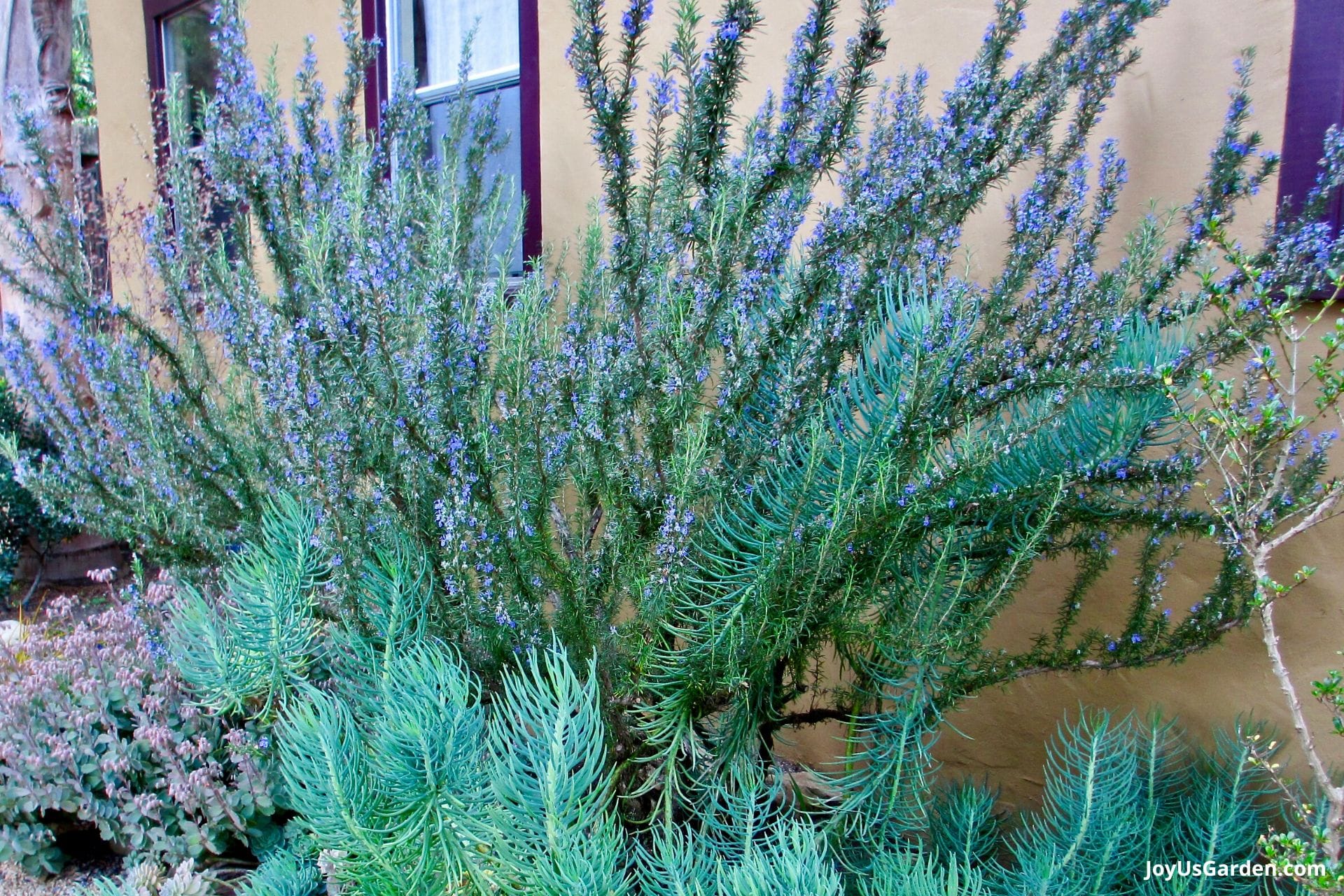
Rosemary Care Tips
Is Rosemary A Perennial?
Yes, rosemary is an evergreen perennial. It’s hardy to 20F.
Growth Rate
Rosemary has a moderate growth rate after getting established. In the first couple of years after planting, it can be slow to go to take off.
I just planted a Rosemary “Tuscan Blue” in my back garden a couple of months ago. I don’t expect to see much growth for a year or 2.
How much sun does Rosemary need?
Rosemary does best in full sun. It can take bright morning shade but needs that midday and afternoon sun to look its best.
If the light levels are too low, the plant won’t grow and will eventually die. Remember, rosemary is native to the Mediterranean where the temps are warm and the sun shines abundantly.
My “Tuscan Blue” grows in the all-day sun here in Tucson. Arizona is the sunniest state in the US so you know it loves the sun and heat!
How much water does Rosemary need?
It needs regular watering to get established. Depending on your temps, every 2-7 days in the warmer months. Here in Tucson, my newly planted rosemary is being dripped every other day. In Santa Barbara, it was every 7 days.
After the plant is established, you can back off to more infrequent and deeper waterings. This would be every 1-4 weeks depending on the soil it’s growing in and your climate.
Be careful not to overwater your rosemary (too often) because this plant is subject to root rot, especially if growing in heavier and less aerated soil.
Rosemary Soil Requirements
You want to make sure the soil drains really well and that it’s well aerated. What you add to amend drainage (if you need to) varies depending on your soil type.
I added loam to my Santa Barbara garden. Rosemary isn’t particularly fussy as to soil type but I will say that it prefers soil more on the alkaline side rather than acidic.
It can even do well in clay soil if it’s not too heavy and dense and/or kept too wet.
Temperature/Humidity
Rosemary is versatile when it comes to these 2 points but it does require good air circulation. The climate here in Tucson is quite different from Santa Barbara and rosemary does well in both locations.
Just know that Rosemary can be subject to mildew. I had this happen to a rosemary plant I was growing in a container in a corner of my house in Santa Barbara. Upon noticing the mildew build-up I moved the plant away from the wall and to a location with better air circulation.
Mildew thrives in moist and humid conditions so having proper ventilation is key. Rosemary doesn’t mind a bit of mist, as long as the air circulates. If you live in a high humidity climate with a good amount of rain, your rosemary could struggle.

Feeding/Fertilizing Rosemary
Rosemary doesn’t require much in terms of food and fertilizer. For mine in Santa Barbara, I would compost them every 2 – 3 years in the late winter.
If your rosemary is looking a bit yellow and pale, you could feed it once in late spring with something like this all-purpose fertilizer.
Soil
Rosemary is fairly adaptable in regard to soil as long as it drains freely. When planting my Santa Barbara garden, I mixed an amendment from a local landscape company into the beds with a good amount of loam in it.
I had a client in the San Francisco Bay Area on the coast who wanted a rosemary plant. Her soil had a good amount of clay in it, so we planted it on a hillside where the water could run off. It happened to be the sunniest part of the garden so the rosemary did well.
Pruning Rosemary
If your rosemary is newly planted, you won’t have to prune it for at least a couple of years.
I would give my Rosemary Tuscan Blue in Santa Barbara a really good pruning every spring after flowering. Because it was growing so big, I needed to take out whole branches with the saw to give it a better shape and allow some room for the plants growing next to it.
As those big branches grew, they would get heavy and I would prune them to lighten. I also removed branches that were crossing over or were growing too densely.
Throughout the year I’d give a light pruning to keep it in check. Depending on the size and shape of yours, you may only need to prune it when harvesting those fragrant tips.
As your rosemary grows and ages, the more pruning and shaping it’ll need. There are a few varieties that stay on the smaller side and won’t require as much pruning to control the size and/or look good.
Related: Pruning An Oregano Plant: A Perennial Herb With Soft Woody Stems
Propagating Rosemary
Propagating rosemary is easy. I always did it by stem cuttings in water which was always successful for me.
I took cuttings about 5-8″ long, not the tender new growth at the ends but not the old thicker woody growth either. I’d then strip off the lower leaves (enough so there’s no foliage in the water) and put the stems into a jar or vase with water.
Make sure 2 or 3 of the bottom nodes are in the water because that’s where the roots come out. When they put out substantial root growth, I would plant them into a loose mix.
Cold Hardiness
Rosemary can show damage if the temp dips below 20 degrees F. There are 2 varieties, “Arp” and “Madeline Hill”, that are more cold-hardy than the others.
If you are growing yours in a container and are in a cold climate, bring your plant indoors for the winter months. See more on growing rosemary indoors further on down.
Rosemary Pests and Diseases
Mine have never had any pests. My client’s in the San Francisco Bay Area would routinely get a little spittlebug which I just hosed off.
I’ve read that they can be susceptible to spider mites, mealy bugs, and scale.
Rosemary can also be subject to mildew, a fungal disease, which we touched on in temp/humidity.
Does Rosemary Flower?
Oh yes, it does! My “Tuscan Blue” got covered with beautiful light blue flowers. They’re abundant in the winter and spring, depending on your growing zone.
Mine would flower off and on throughout the summer but nowhere near as abundantly as that 1st big bloom in late winter.
Rosemary flowers are usually some shade of blue but some varieties have white, pink, or lavender/blue blooms.
In order to get your rosemary to flower, it needs full sun. If it’s not getting enough sunlight, the flowering will be scant or non-existent.
Related: Mint: How To Care For and Plant This Fragrant Herb, How To Prune and Feed Mint Plants
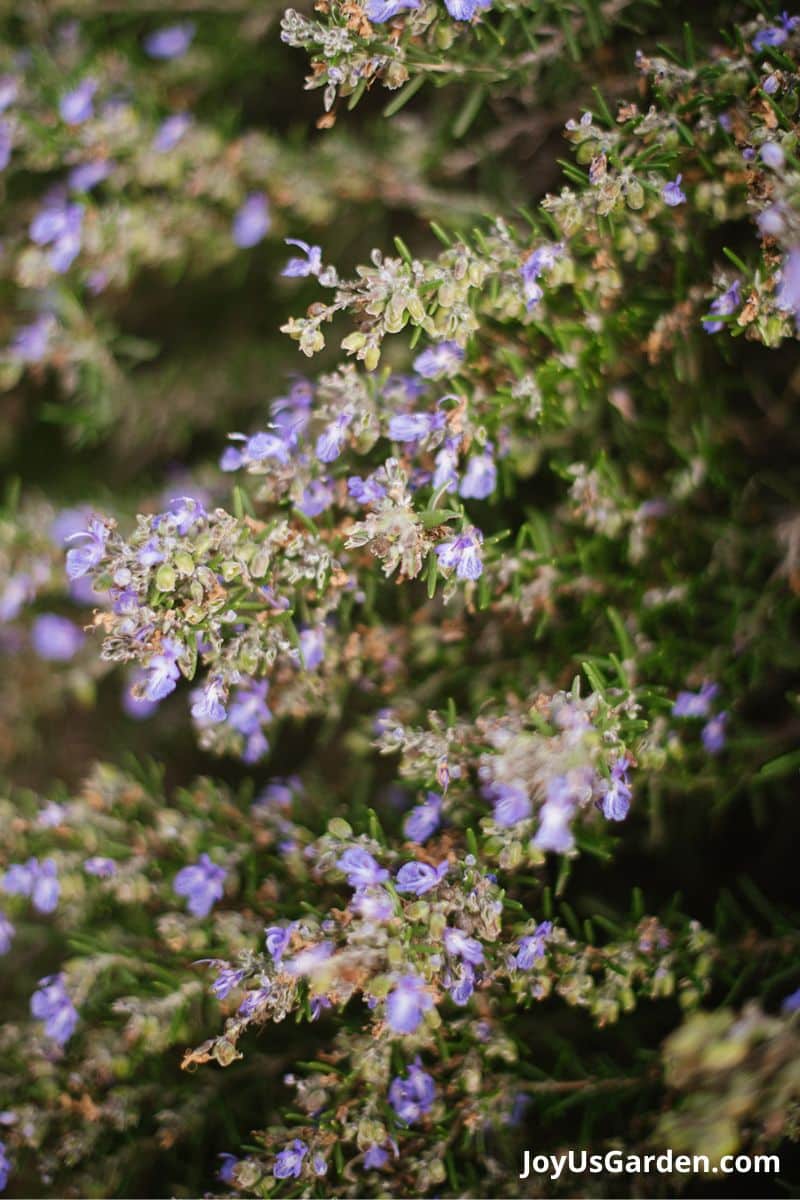
Types of Rosemary
The forms that rosemary comes in are upright, ground cover or trailing, and a combo of the 2. The most commonly sold upright rosemary are Tuscan Blue, Golden Rain (I grew both of these in Santa Barbara), Tuscan Spires, and Miss Jessup.
A few of the trailing types include; Irene, Huntington Blue and Prostratus (this is the most commonly sold trailing rosemary in the landscape trade). You will also see “semi-trailing” varieties which have growth habits of both upright and trailing these would be; Collingwood Ingram, Ken Taylor, and Boule.
If you’re interested in growing rosemary for culinary purposes, professional and home chefs favor “Tuscan Blue” and “Tuscan Spires” in terms of taste. (I prefer to use the tender new growth for cooking.)
There are many varieties of Rosemary on the market now. We’ve compiled 10 types that can be grown in your garden and used for your culinary delights. To find out if you are in the right growing zone use this helpful USDA Plant Hardiness Zone Map.
Roman Beauty has arching stems and in the spring you’ll be amazed to see lavender-blue flowers.The aromatic, needle-like evergreen foliage is valued as a culinary herb. USDA Zones 8-10.
Barbeque Rosemary has remarkable flavor and aroma for cooking.The strong, straight stems make perfect barbecue skewers! A fast-growing, upright shrub with blue flowers. USDA Zones 8-10.
Golden Rosemary is an exceptional plant that displays bright yellow foliage in early spring and late fall. The leaf color varies according to the time of year. USDA Zones 8-11.
Blue Spires this highly aromatic shrub has unique light grey-green foliage, covered with clear blue flowers over a long season. Popular with gardens since it requires little care, once established. USDA Zones 6-10.
Spice Islands Rosemary is named for its exceptional flavor as a culinary seasoning either fresh or dried. An essential for herb or kitchen gardens. USDA Zones 8-11.
Arp Rosemary is a more cold-hardy rosemary. It has the typical rosemary flavor and can be dried or used in any recipe calling for rosemary. USDA Zones 6-11.
Huntington Carpet Rosemary has deep blue flowers and makes for an attractive spreading groundcover. The aromatic leaves are often used as a flavorful culinary seasoning. USDA Zones 8-10.
Pink Rosemary is a weeping form with small leaves and pale pink flowers that cover the plant in late winter and put on quite a show. USDA Zones 8-11.
Trailing Rosemary is a vigorous grower that climbs over itself and easily reaches heights of three feet or more if not pruned. USDA Zones 8-11.
Tuscan Blue Rosemary quickly forms an upright hedge with clear blue flowers. It takes to pruning well but is equally wonderful when left in natural rustic form without pruning. USDA Zones 8-11.
Related: How to Grow a Kitchen Herb Garden
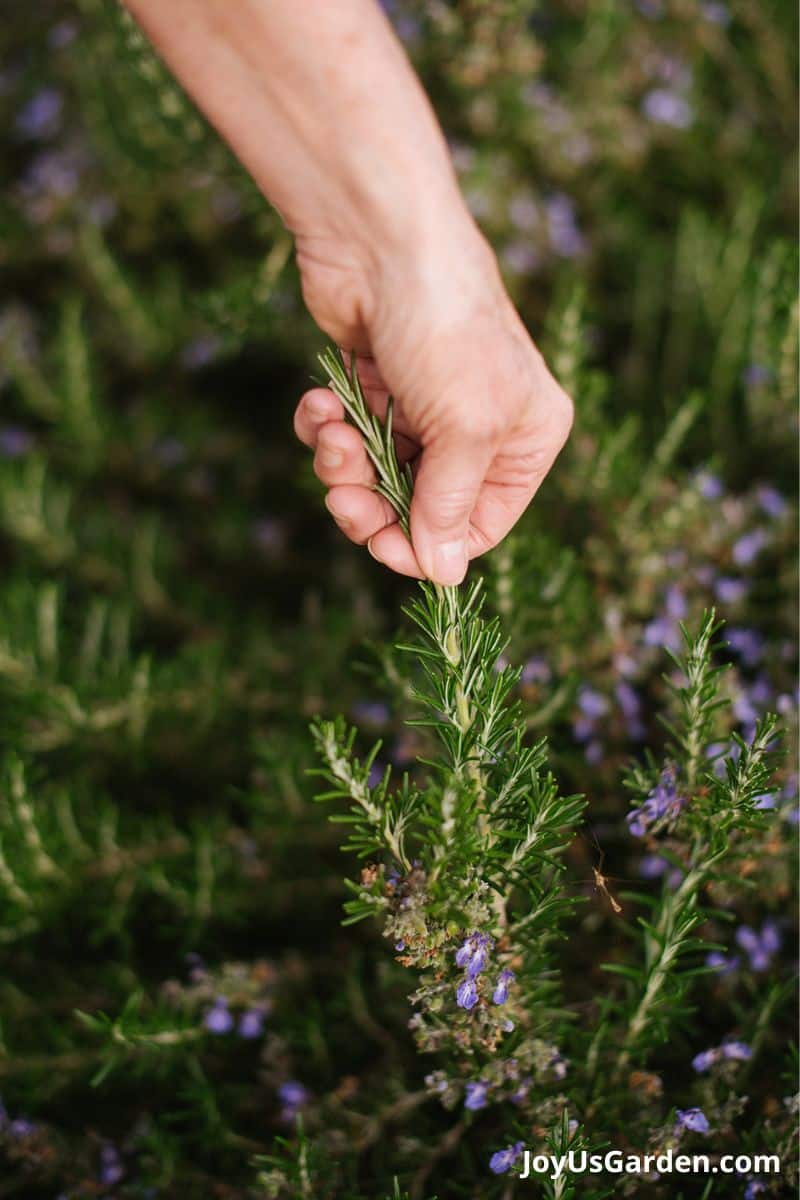
Companion Plants for Rosemary
Are you interested in what plants grow well with rosemary? It’s good to know the conditions rosemary does well in and choose companion plants accordingly.
Rosemary likes heat, can withstand periods of drought once established, tolerates different soil types but requires good drainage, and loves full sun.
Some plants that do well and look good with rosemary are salvia, yarrow, veronica, coneflower, gaillardia, globe thistle, nepeta, agastache, lantana, and marigolds.
What herbs go well with rosemary? In terms of others, I’ve seen it growing with lavender, sage, thyme, oregano, and sweet marjoram.
In my Santa Barbara garden, my rosemary plants grew next to fleshy succulents and plants native to the Mediterranean and Australia.
Here in the Sonoran Desert, rosemary grows alongside cacti, agaves, lantana, dwarf bottlebrush, and the like.
Rosemary in Pots Basics
The care points for rosemary in pots are the same as that of it growing in the ground.
When choosing a container be mindful of the size your rosemary will mature to. You want the plant to be in scale with the pot. You can always start out smaller, and then repot as the plants grow larger.
In terms of material, rosemary does fine in clay, ceramic, and plastic. I think it looks beautiful planted in terra cotta (a type of clay) alongside other herbs.
You’ll want to plant yours in a well-draining soil mix that has a good amount of aeration. When planting rosemary in pots, I use ½ potting soil and ½ succulent and cactus mix.
Your rosemary in a pot will need to be watered more frequently compared to one growing in the ground.
Related: Planting Lavender In Pots
How To Use Rosemary
Rosemary has many uses. Rather than make this any longer than it is, I’ll refer you to this post on Uses For Rosemary.
Growing Rosemary Indoors
Simply put, growing rosemary indoors for the long haul can be a bit of a crapshoot. I’ve only grown it in the house for 2-month periods during the holiday season.
You want to make sure it is receiving strong natural light, in other words a high light exposure, for most of the day.
Be sure not to water yours too often, making sure to let it dry out between waterings. You want all the excess water to thoroughly drain out of the bottom of the pot. In the cooler, darker months, you’ll want to water it even less.
Your rosemary needs drainage holes to prevent root rot. Make sure the soil mix isn’t too heavy, that it drains well, and is aerated. As I touched on above, I mix ½ potting soil with ½ succulent and cactus mix when planting rosemary in pots.
You can take your rosemary outside for the warmer months. It’ll love the sun and heat.
In conclusion: the 3 most important things that you need to know to grow rosemary are that it needs full sun, the soil mix to be well-drained, and not to be kept too wet.
I did a video many moons ago about How I Use Rosemary which you might find interesting. Rosemary is a plant I absolutely love. Ahhhh …. that fragrance is like none other!
Happy gardening,

MORE HELPFUL GUIDES ON GARDENING:
7 Things To Think About When Planning A Garden, Vegetable Container Gardening: A Beginner’s Guide to Growing Food, Organic Flower Gardening: Good Things To Know, How To Successfully Plant Shrubs In The Garden, How To Successfully Plant Perennials, How To Prepare and Plant A Flower Bed, How to Feed Camellias With Great Success, Clean And Sharpen Your Pruning Tools
This post may contain affiliate links. Your cost for the products will be no higher but Joy Us garden receives a small commission. Thank you for helping us spread the word & make the world a more beautiful place!
- About the Author
- Latest Posts
Nell, the founder of Joy Us garden, was born into a gardening family and grew up in Connecticut’s countryside. After living in Boston, New York, San Francisco, & Santa Barbara, she now calls the Arizona desert home. She studied horticulture & garden design, working in the field all her life. Nell is a gardener, designer, blogger, Youtube creator, & author. She’s been gardening for a very long time & wants to share what she’s learned with you.


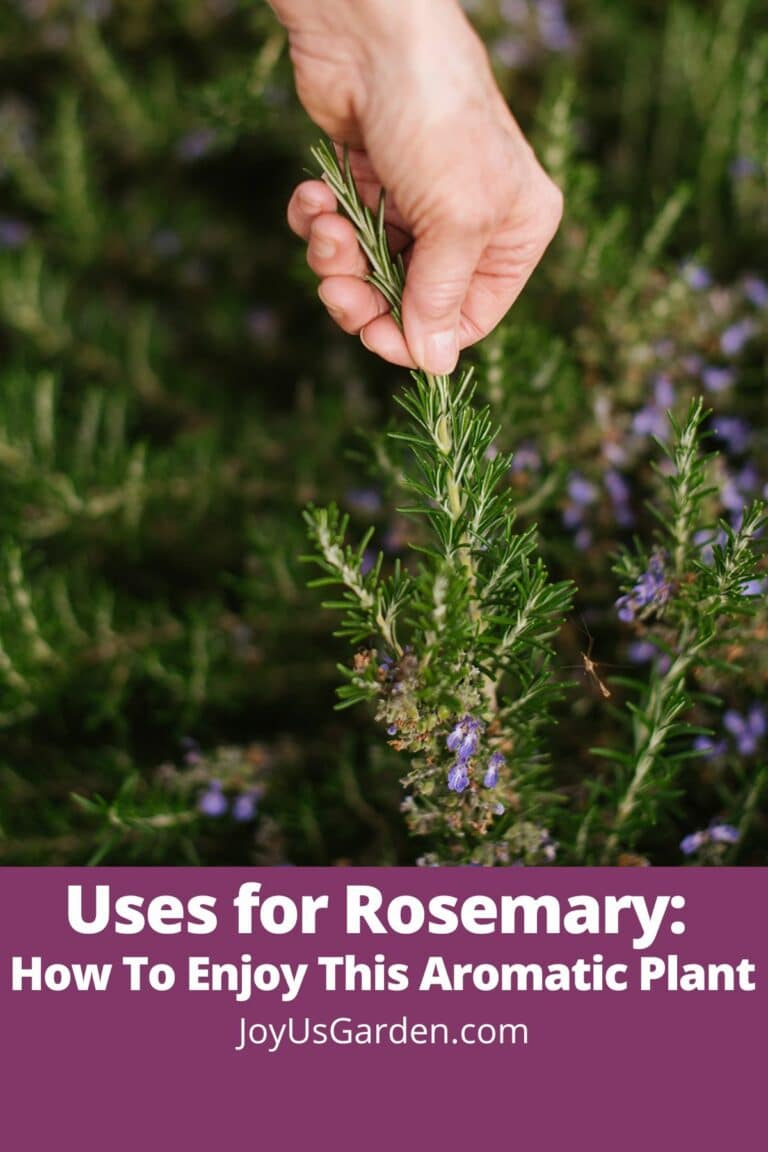

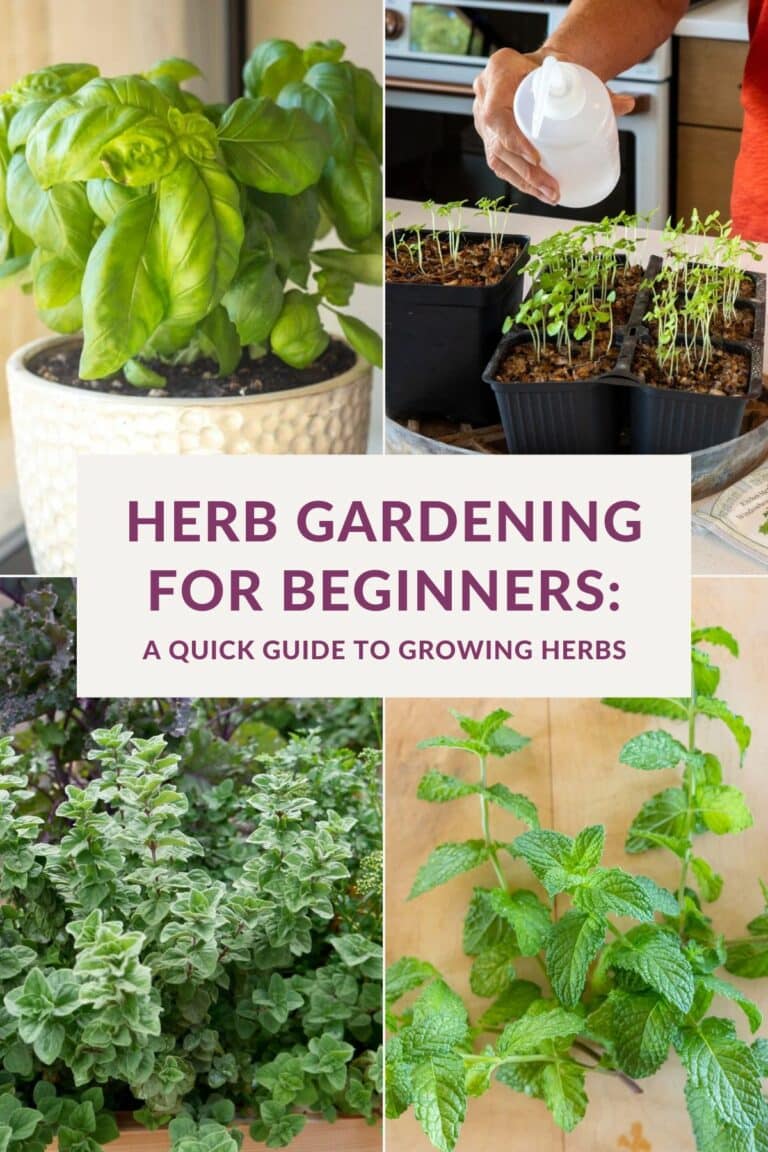


You’re very welcome Charis Fay Jacobson! I now live in Tucson,AZ & rosemary survives the desert heat. I love the smell & the bees love the flowers. Glad you’re enjoying it too. Nell
Hello, I live in southern Arizona and I have had my Tuscan Blue Rosemary planted for about a month now, and they are neither growing nor dying. I’m very worried about them. I have 9 planted in my front yard to create a wall from my neighbors. I water them using a drip system. Occasionally I water using sprinkler for more watering. They get full sun as directed on package, please help I don’t want to lose them. Thank you.
I have had good rosemary plants in big lots outside in Albuquerque. The flowers last all winter except one time when it was extra cold. Once it recovered, it bloomed again beautifully. But this spring the house finches are them all! I wonder when they’ll bloom again.
Cathy – Rosemary blooms in spring so you may have to wait until next year. Nell
Reva – I now live in Tucson. It sounds like the sun exposure is fine. You want to make sure the soil is well-drained. For this 1st growing season, you’ll need to water them every 5 days until they get established. Nell
Thanks Nell, I’ll let you know how they are doing if they ever get growing. ?